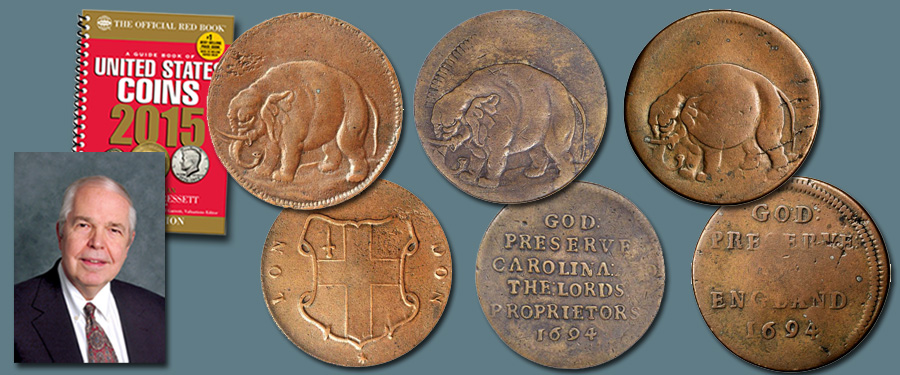
Welcome to my latest week in the tour of A Guide Book of United States Coins, 2015 edition (the 2016 edition is out, but still is in early distribution). You can follow along in your copy. The subject for this week is Elephant tokens under the heading of “Early American and Related Tokens” on page 46. As Winston Churchill might have said, Elephant tokens are a mystery wrapped up in an enigma. We all know what Elephant tokens look like, we enjoy collecting them, but relatively little is known about their origins. There are three main types, the first saying GOD PRESERVE LONDON, the second saying GOD PRESERVE NEW ENGLAND 1694, and the third saying GOD PRESERVE CAROLINA AND THE LORDS PROPRIETERS 1694 (and a variety with the 0 in PROPRIETORS corrected from the previous E).
The London tokens were undated, but were probably struck between 1672 and 1694. Regarding GOD PRESERVE LONDON, some think it may refer to the 1665 plague and the 1666 fire that ravaged London, although that is merely speculation. No one quite knows what the date 1694 refers to on the New England and Carolina tokens. It may have been the year of issue.
As for the elephant, these large pachyderms were objects of curiosity in London and were occasionally exhibited, but have no connection with London itself, New England or the Carolinas. There is no evidence that any of these tokens circulated in the American colonies. However, the reference to New England and the Carolinas has made them popular with American collectors. T. Snelling in his 1769 survey, On Coins of Great Britain, Part V, “Pattern Pieces,” did not mention the New England issues but did says this of the Carolina piece:
“We cannot ourselves conceive the intent of striking it, or for what purpose it was intended; however, we think it has no claim to be admitted as a piece of money, but rather is of the ticket kind, and we are of the same opinion in regard to another piece, which is certainly of the same class with this; be it what it will, it is what we call the London halfpenny, one side of both, that is the elephant, we apprehend was struck from the same die, which is still remaining in the Tower [the Tower of London, once used as a mint], and appears to be the work of [John] Roettier; on the other side instead of GOD PRESERVE CAROLINA AND THE LORDS PROPRIETORS, 1694, as upon this; there is upon that, round the city arms, GOD PRESERVE LONDON; we have heard two or three opinions concerning the intent of uttering this piece, as that it was for the London Workhouse; also, that its inscription alludes to the plague, and it was struck whilst it raged in London; and we have likewise heard that it was intended to be made current at Tangier in Africa but never took place.”
A recent theory which seems to have extraordinary merit was proposed by R. Neil Fulghum in “The Hunt for Carolina Elephants: Questions Regarding Genuine Specimens and Reproductions of the 1694 Token,” 2003. These may have been used within London itself at coffee houses named New England and Carolina that were in business at that time. If so, these pieces have no direct connection at all with America. Moreover, it is unlikely that any token relating to America would be inscribed NEW ENGLAND, as the Massachusetts Bay Colony was the name of the main settlement, and Connecticut was independent of it. There was no formal or informal group of colonies acting as New England, although NEW ENGLAND did appear on certain Massachusetts silver coins. Again, facts are scarce.
Today the London Elephant tokens are very collectible as a type, although varieties exist, some of which are rare. Nearly all of these, perhaps every one, can trace its origin to England and various coin dealers and sellers there. The typical issue tends to be in higher grades such as VF and EF, although AU is not uncommon. Mint State pieces are seen now and again when important collections cross the auction block.
The Carolina token, with two lettering varieties, is rare, but not exceedingly so. The Guide Book lists VF at $13,000 and $12,500. The New England token is an extreme rarity, with just three known.





